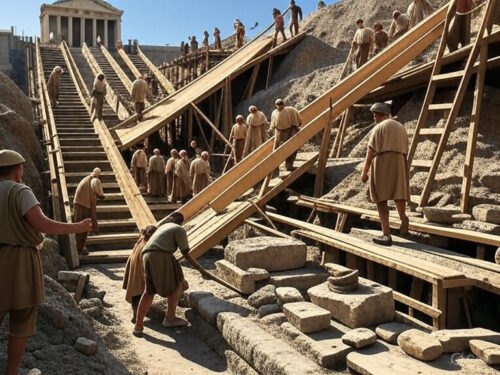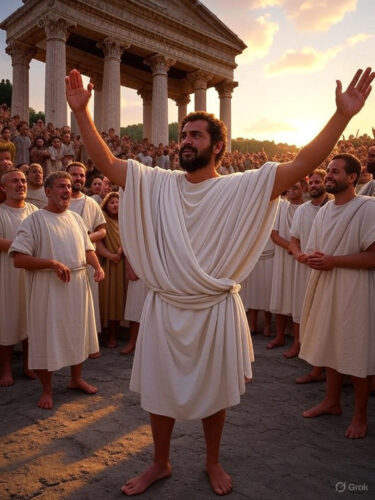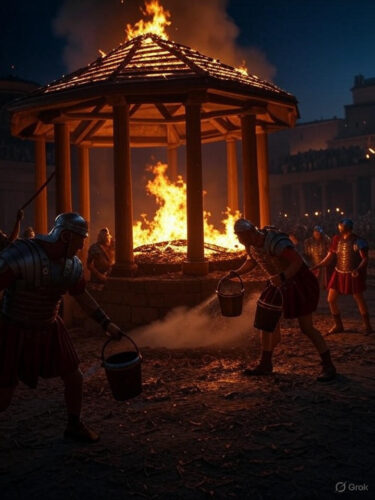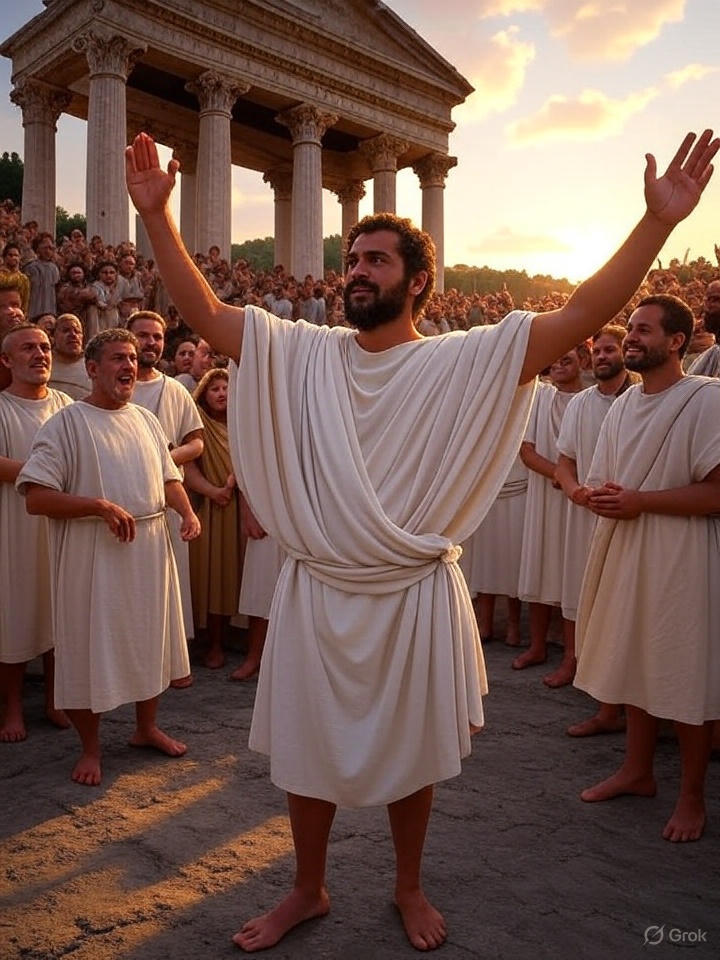Imagine standing atop the rugged Capitoline Hill in ancient Rome, the air thick with the scent of freshly hewn stone and smoldering incense. The year is 509 BC, and the city is buzzing with a mix of trepidation and triumph. The tyrannical king has been banished, the old order shattered, and in its place rises a symbol of hope, power, and divine favor: the Temple of Jupiter Optimus Maximus. On this fateful September 13, as the sun casts long shadows over the Tiber River, the grand dedication ceremony unfolds, marking not just the consecration of a magnificent structure, but the birth of the Roman Republic itself. This event, steeped in legend, politics, and architectural marvel, wasn’t merely a religious rite—it was the cornerstone of an empire that would shape the world for centuries.
In this exploration, we’ll dive deep into the historical tapestry of that day, unraveling the threads of monarchy’s fall, the temple’s laborious construction, and its enduring legacy. We’ll journey through the myths and facts that defined ancient Rome, from the dramatic tale of Lucretia’s tragedy to the intricate rituals that consecrated the sacred site. And as we emerge from the mists of time, we’ll see how this ancient milestone offers timeless lessons for personal empowerment today—lessons on resilience, justice, and legacy-building that anyone can apply to forge their own path to greatness. Get ready for a thrilling ride through history that’s as educational as it is exhilarating!
### The Shadow of the Tarquins: Rome’s Monarchical Twilight
To understand the significance of September 13, 509 BC, we must first rewind to the turbulent final days of Rome’s monarchy. The Roman Kingdom, established around 753 BC according to tradition, had seen seven kings rule over the city-state. The first, Romulus, was a legendary founder, said to have been suckled by a wolf and ascended to godhood. But by the late 6th century BC, the throne had fallen into the hands of the Etruscan Tarquin family, whose rule devolved into despotism.
Lucius Tarquinius Priscus, the fifth king, was an ambitious outsider from the Etruscan city of Tarquinii. Arriving in Rome as a wealthy immigrant, he rose through cunning and alliances, eventually seizing power after the assassination of his predecessor. Priscus is credited with grand public works, including the Circus Maximus and the Cloaca Maxima sewer system, but his most enduring legacy was vowing the Temple of Jupiter Optimus Maximus during a fierce battle against the Sabines around 578 BC. According to the historian Dionysius of Halicarnassus, Priscus began the massive terracing project on the Capitoline Hill, a steep, rocky outcrop sacred to early Roman cults. This hill, one of Rome’s seven, was already home to ancient shrines, including those to Terminus (god of boundaries) and Juventas (goddess of youth), which would later play pivotal roles in the temple’s story.
Priscus’s son, Lucius Tarquinius Superbus—known as Tarquin the Proud—succeeded him in 535 BC. Superbus was a tyrant in every sense: arrogant, ruthless, and focused on personal glory over public welfare. He expanded Rome’s influence through wars against neighboring Latin tribes and the Volsci, but at home, he ruled without the traditional Senate’s counsel, executing senators who opposed him and filling the body with his cronies. Superbus completed much of the temple’s foundations, using forced labor from conquered peoples and even slaves. Livy, the great Roman historian writing in the 1st century BC, describes how Superbus oversaw the excavation of the site, mining blocks of Cappellaccio tufa—a soft volcanic rock—from the hill itself to level the terrain. This was no small feat; archaeological evidence from modern coring confirms the extensive earthworks, which transformed the uneven summit into a stable platform.
But Superbus’s reign was marred by personal scandals that would ultimately doom the monarchy. His sons, including the notorious Sextus Tarquinius, embodied the family’s excesses. The tipping point came in 509 BC, when Sextus, posted as a military commander in the Latin town of Collatia, committed an unforgivable act. The story, immortalized by Livy and Ovid, revolves around Lucretia, the virtuous wife of Lucius Tarquinius Collatinus, a Roman noble and relative of the king. During a drunken boast among officers about their wives’ faithfulness, Collatinus praised Lucretia’s chastity. Sextus, inflamed by lust, rode to Collatia under the cover of night, gained entry to her home by claiming urgent military news, and then threatened her with disgrace by accusing her of adultery with a slave if she resisted. Overpowered, Lucretia succumbed but, the next morning, summoned her husband, father, and Lucius Junius Brutus—a close friend and kinsman—to reveal the assault. In a dramatic act of defiance, she plunged a dagger into her heart, declaring that her death would avenge her honor.
This tragedy ignited a firestorm. Brutus, long suspected of feigning foolishness to avoid Superbus’s purge (earning him the nickname “Brutus the Dumb”), pulled the bloodied dagger from Lucretia’s body and rallied the outraged nobles. “How long, Romans, shall we suffer the Tarquins to lord it over us?” he thundered, according to Livy. Leading an armed uprising, Brutus and Collatinus marched on Rome, expelling Superbus and his family. The king fled to Etruria, seeking aid from his allies, but the Roman Senate declared the monarchy abolished. In its place, the Republic was born: two annually elected consuls would share power, checked by veto rights, ensuring no single ruler could dominate.
This revolution wasn’t just political; it was deeply religious. The Romans saw the gods’ hand in the events. Augurs—priests who interpreted omens—had long warned of the monarchy’s perils. The temple project, vowed under Priscus but unfinished under Superbus, became a symbol of renewal. With the king gone, the new leaders turned to completing and dedicating it, tying the Republic’s legitimacy to Jupiter’s favor.

### The Architectural Marvel: Building Rome’s Crown Jewel
The Temple of Jupiter Optimus Maximus was no ordinary structure; it was a colossal testament to Roman ambition, blending Etruscan influences with emerging Italic styles. Spanning nearly 60 meters by 60 meters—larger than any temple in the region for centuries—it dominated the Capitoline’s southern peak. The foundations, laid by Superbus, were massive: deep trenches filled with tufa blocks, designed to withstand earthquakes and the hill’s instability. The superstructure rose in wood, a practical choice for the era, with walls of sun-dried brick and a roof of terracotta tiles.
Etruscan artisans, masters of sacred architecture, were instrumental. The temple followed the Etruscan plan: a deep podium (about 6 meters high) accessed by a grand front staircase, with three cellae (inner chambers) aligned side-by-side rather than in a row. The central cella housed Jupiter Optimus Maximus, king of the gods; to his left, Juno Moneta (later Regina), protector of women and state funds; to the right, Minerva, goddess of wisdom and crafts. This Capitoline Triad embodied Rome’s core values: power, marriage, and intellect.
The facade boasted three fluted columns in the Tuscan order—simpler than Greek Doric, with unfluted shafts and bulbous capitals—supporting a wide entablature. The pediment, or triangular gable, featured terracotta sculptures by Vulca of Veii, the famed Etruscan sculptor. Atop the roof stood a massive quadriga: a bronze chariot drawn by four horses, driven by Jupiter himself, symbolizing thunder and victory. Inside, the cult statue of Jupiter was awe-inspiring: a standing figure over 10 meters tall, clad in a embroidered tunic (tunica palmata) and a painted toga (toga picta), holding a thunderbolt and scepter. This image would inspire Roman generals’ triumph processions for generations.
Construction details reveal the project’s scale. Livy notes that Superbus imported materials from across Italy: timber from the Apennines, bronze from Etruria. The site preparation involved relocating shrines, but Terminus and Juventas refused to yield—portents interpreted as signs of Rome’s eternal borders and perpetual youth. During foundation digging, workers unearthed a human head (caput in Latin), which Etruscan augurs declared meant Rome would be the “head” of the world. These omens fueled the builders’ zeal.
The temple wasn’t just a place of worship; it was a political hub. The cellae stored state treasures, including the Aerarium (public treasury) in Juno’s chamber. Senate meetings occasionally occurred in its portico, and victorious generals dedicated spoils here. Rituals were elaborate: annual festivals like the Capitoline Games (Agon Capitolinus) featured chariot races and theatrical performances in honor of the gods.

### The Dedication Ceremony: A Day of Divine and Civic Triumph
September 13, 509 BC, dawned with anticipation. The new consuls—Lucius Junius Brutus and Lucius Tarquinius Collatinus—drew lots for duties, and Marcus Horatius Pulvillus, one of the consuls (accounts vary slightly on the exact pairing), was chosen to dedicate the temple. This was no mere formality; dedication (inauguratio) was a sacred act, requiring perfect auspices. Horatius, a patrician of unyielding resolve, ascended the podium amid throngs of citizens, senators, and priests.
Livy paints a vivid scene: Horatius, dressed in a white toga, touched the temple doors while reciting prayers to Jupiter, Juno, and Minerva. As he invoked the gods’ protection for the Republic, a rival—possibly a Tarquin sympathizer—shouted that ill omens had appeared, hoping to discredit him. Undeterred, Horatius declared the gods’ favor evident in the temple’s completion and Rome’s liberation. With hands outstretched, he consecrated the site, and the crowd erupted in cheers. Sacrifices followed: white bulls slain on altars, their entrails examined by haruspices for approval. Incense smoke rose, mingled with the chants of flamines (priests) and the music of tibiae (flutes).
The ceremony symbolized the Republic’s divine mandate. By dedicating the temple vowed under the kings, the new leaders cleansed the monarchy’s stain while claiming its glory. Plutarch and Cassius Dio corroborate the date, though Dionysius suggests 507 BC, likely due to calendar discrepancies. Regardless, September 13 became an annual holiday, the Dies Templi, celebrated with games and feasts.
Post-dedication, the temple’s role expanded. In 495 BC, Latin allies gifted a golden crown in thanks for prisoner releases. During triumphs, generals ascended the Capitoline to offer spoils at Jupiter’s altar, a tradition starting with Brutus himself after defeating Tarquin’s Etruscan allies at Arsia in 504 BC.

### The Temple’s Enduring Legacy: From Flames to Phoenix
The Temple of Jupiter stood as Rome’s spiritual heart for over four centuries, but it wasn’t immune to fate’s whims. In 83 BC, during Sulla’s civil wars, lightning struck the roof, igniting the wooden beams and destroying the quadriga and much of the interior. Sulla, the dictator, rebuilt it in marble, adopting Greek influences with Corinthian columns. Yet fire struck again in 69 AD under Nero, reducing it to ashes. Vespasian rebuilt in 75 AD, and Hadrian refined it further, but the ultimate blow came in 80 AD when another blaze, possibly arson during Titus’s reign, gutted it once more.
Domitian’s reconstruction in 81 AD was the last major effort: a opulent version with gilded ceilings, mosaic floors, and colossal statues. By then, the temple symbolized imperial power, with emperors like Trajan dedicating spoils from Dacian wars. It survived until the 5th century AD, when Alaric’s Visigoths sacked Rome in 410 AD, stripping its treasures. The site lay in ruins until the Renaissance, when Michelangelo incorporated remnants into the Palazzo dei Conservatori.
Archaeologically, excavations since the 19th century have uncovered podium fragments, terracotta antefixes depicting gods and myths, and foundation blocks. These artifacts, housed in the Capitoline Museums, reveal the temple’s evolution from Etruscan austerity to imperial splendor. Myths abound: Pliny the Elder describes the cult statue sweating before disasters, a portent of doom. Virgil’s Aeneid ties the temple to Rome’s Trojan origins, with Jupiter promising eternal rule.
The temple’s political significance was profound. It hosted the Senate during crises, like after Cannae in 216 BC, and was the endpoint of triumphs, reinforcing Roman identity. Religiously, it anchored the state cult, with flamines maintaining eternal flames. Its dedication on September 13 encapsulated Rome’s ethos: from tyranny to liberty, under the gods’ watchful eye.

### Echoes Through Time: The Temple’s Influence on Roman Culture and Beyond
The Temple of Jupiter didn’t just dominate Rome’s skyline; it permeated every facet of Roman life. Festivals like the Epulum Jovis, a lavish banquet for the gods on September 13, involved senators serving meals to statues, blending piety with politics. The temple’s treasures—spolis opimae (spoils from enemy kings)—included armor from defeated foes, displayed as trophies.
In literature, Cicero invoked the temple in speeches, urging senators to uphold republican virtues. Poets like Horace praised its majesty, linking it to Rome’s destiny. Militarily, it inspired legions; before battles, commanders sought Jupiter’s auspices here. Economically, as treasury holder, it funded wars and public works.
As Rome expanded, provincial temples mimicked its design, spreading Roman culture. In Jerusalem, Pompey’s 63 BC triumph saw Jewish artifacts paraded to the Capitoline. Even in defeat, like after Teutoburg Forest in 9 AD, Varus’s lost eagles were vowed for recovery at Jupiter’s altar.
The temple’s fall mirrored Rome’s: each rebuild reflected the era’s turmoil. By the Christian era, it was abandoned, its site quarried for churches. Yet, its legacy endures in Western architecture—capitols derive from “Capitoline”—and in concepts of civic religion.

### Applying Ancient Wisdom: How the Temple’s Legacy Empowers Your Life Today
Now, fast-forward 2,500 years. The dedication of the Temple of Jupiter on September 13, 509 BC, isn’t dusty trivia—it’s a blueprint for personal transformation. Just as Romans turned tyranny into triumph, you can harness this event’s lessons to build your own “temple”: a foundation of strength, purpose, and legacy. The historical fact that a city reborn from outrage created an enduring symbol teaches resilience, justice, and visionary action. Here’s how to apply it specifically to your individual life, with targeted bullet points and a step-by-step plan to motivate you toward greatness.
– **Embrace Justice as Your Catalyst for Change**: Lucretia’s stand against injustice sparked Rome’s revolution. In your life, identify personal “tyrants”—toxic habits, unfair situations at work, or self-doubt—and confront them head-on. For instance, if a colleague undermines you, document instances and address it assertively, much like Brutus rallying allies, to reclaim your professional dignity and open doors to promotions.
– **Build Foundations with Relentless Effort**: The Tarquins’ forced labor on the temple’s base shows that great achievements require groundwork, even under duress. Apply this by auditing your daily routines: dedicate 30 minutes nightly to skill-building (e.g., learning coding via free apps), laying a “tufa foundation” for career advancement, turning incremental efforts into a towering personal empire over months.
– **Seek Divine (or Inner) Omens for Confidence**: The head omen and unmovable shrines gave Romans assurance. Today, interpret “signs” in your pursuits—positive feedback as Terminus’s steadfastness. When starting a side hustle, like launching an online store, track small wins (first sale) as affirmations, boosting your resolve to persist through setbacks, just as Horatius ignored doubters.
– **Dedicate Your “Temple” with Ritual and Celebration**: Horatius’s ceremony marked completion with public rite. Create personal milestones: after achieving a goal (e.g., fitness transformation), host a solo “dedication” ritual—journal gratitudes, share on social media—to solidify gains and motivate future endeavors, fostering a habit of triumphant reflection.
– **Guard Against “Fires” with Adaptive Rebuilds**: The temple’s repeated burnings and reconstructions highlight renewal. In life, when failures strike (job loss), rebuild stronger—update your resume, network aggressively—emerging more resilient, like Domitian’s gilded version, to achieve greater stability and success in volatile times.
**Your Personalized Plan: Forge Your Capitoline Legacy in 30 Days**
- **Days 1-7: Unearth Your Lucretia Moment (Awareness Phase)**: Journal daily about injustices or stagnation in your life. Identify one key issue (e.g., career rut). Research solutions, like courses or mentors, mirroring Brutus’s strategic uprising. End the week with a bold action: schedule a tough conversation.
- **Days 8-14: Lay the Foundations (Construction Phase)**: Commit to 1-hour daily blocks for foundational work. If it’s health, meal-prep nutritious foods; for finances, track expenses and create a budget. Visualize your “temple” as a mental image of success, drawing from the Capitoline’s solidity to stay motivated.
- **Days 15-21: Invoke Omens and Overcome Doubters (Dedication Prep)**: Seek feedback from trusted friends on your progress. Note positive “omens” (e.g., unexpected opportunities). Practice affirmations: “Like Horatius, I consecrate my path.” Push through resistance, such as procrastination, with timed challenges.
- **Days 22-28: Perform the Dedication (Celebration Phase)**: Achieve a mini-milestone (e.g., complete a project phase). Ritualize it: prepare a special meal, reflect on growth. Share your win publicly to build accountability and joy.
- **Days 29-30: Plan for Rebuilds (Legacy Phase)**: Anticipate obstacles—draft a “fire contingency” (backup skills or savings). Review the month: what endured like Terminus? Set a 90-day extension, ensuring your personal republic thrives eternally.
This plan isn’t abstract; it’s actionable fuel to propel you forward. The Romans didn’t just survive—they soared. You can too, turning September 13’s ancient echo into your modern symphony of success. History isn’t past; it’s your power source!

